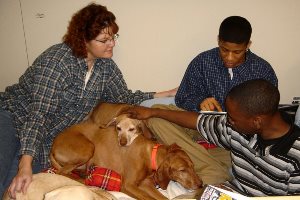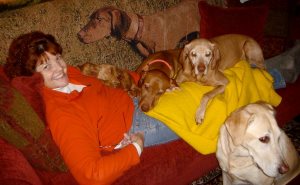You are here
Hepsi Zsoldos Story
![]() I wish there was a way to get my sister's story out to potential moms.
I wish there was a way to get my sister's story out to potential moms.
In June 2012, my sister received the world's first double umbilical stem cell transplant for Rheumatoid Arthritis (R.A.). Two women were brave enough to bank their blood - one in 1998 and one in 2010. And both were used for my sister.
Within 48 hours, my sister was able to pop the tab of a soda can - something she hadn't been able to do in 20 years. In 72 hours, her finger joints were no longer swollen: Deformed from damage and surgery, but not the swollen, angry appendages they had been a week earlier. 96 hours later, she was able to snap her fingers, and by September, we found she was 100% engrafted. It worked! Those wonderful women changed my sister's life and medical research.
Sadly, my sister died in January, 2013 after a long fight with repeated bouts of sepsis. The stem cell transplant didn't cause or exacerbate that condition.
If you Google "Hepsi Zsoldos" you can get a sense of what an extraordinary person she was. She was a brilliant, talented, educator who had a unique knack of making the impossible likely. As her sister though, I can also say she also had an amazing ability to make the likely almost impossible!
In 2010, a friend of hers almost randomly forwarded an ongoing study to her regarding stem-cell research and R.A. We both knew that this was the long-awaited breakthrough she had needed. Diagnosed in 1988, she spent much of her life watching one door after another close: Marine science researcher; Opera Singer; Doctor. For every door that closed, she found a new one and either pushed a battering ram through it or picked the lock.
After becoming an 8th-grade science teacher, she discovered Embrel - a life-altering drug. Within 6 weeks she went from applying for disability to climbing a ropes course. She went to San Francisco and filmed a commercial for the company. It was amazing… until she received a bad batch, and at the same time was assaulted by three students while trying to break up their in-school attack on a fourth. Two more student-related incidents and she found herself on disability, looking for another door to open.
 It was a slow decline from there. Back on methotrexate, steroids, pain meds, physical therapy... and finally the biologics. She tried Orencia without result, and then she tried Remicade. Bad choice. She became septic with Streptococcus bovis. She survived, had her gallbladder removed (the most common source of S. bovis), but was debilitated. In order to rehab herself, she (with typical focus) threw herself into dog agility training and began working with a local dog-support group using dogs to help teach autistic children. She tried Rituxan. No bad result, but no improvement.
It was a slow decline from there. Back on methotrexate, steroids, pain meds, physical therapy... and finally the biologics. She tried Orencia without result, and then she tried Remicade. Bad choice. She became septic with Streptococcus bovis. She survived, had her gallbladder removed (the most common source of S. bovis), but was debilitated. In order to rehab herself, she (with typical focus) threw herself into dog agility training and began working with a local dog-support group using dogs to help teach autistic children. She tried Rituxan. No bad result, but no improvement.
Then we heard about the study. We immediately wrote to the researcher at Northwestern University. She fit all the criteria, except one: She hadn't tried Humira yet. So she did, with disastrous results. Septic once again with S. bovis, she confounded her doctors as to the source. But she pulled through, surprising the doctors, not us.
She threw herself, with typical "sisu," (a Finnish word that encompasses pigheadedness, courage, fearlessness, and hope) into getting into the study. My brother and I proved to be almost-matches, which meant we couldn't help her - there had to be a perfect match. Then the doctor and Hepsi decided to try the umbilical stem cell route. It had been used on other disease processes, but not R.A. Two cord-blood units were found to be matches and we were ecstatic, but hesitant. Hepsi batted away any objections, but there was one she had to overcome: The financial.
 Former students and friends rallied around Hepsi, running auctions, beef and beers, garage sales and a 5K. A website called was set up, and then, when we least expected it, the rest of her funding came through from an unexpected source, and we were off to Chicago.
Former students and friends rallied around Hepsi, running auctions, beef and beers, garage sales and a 5K. A website called was set up, and then, when we least expected it, the rest of her funding came through from an unexpected source, and we were off to Chicago.
I stayed with her as her immune system was ablated with chemotherapy, celebrated with her as her white counts and neutrophils went to "zero" and held a birthday party for her in honor of her new life as her stem cells were infused. She named them "Watson" and "Crick." The rest is as I described above.
A month after Watson and Crick became part of her, her old nemesis, sepsis, returned with a vengeance. She spent the next 6 months in and out of the hospital and nursing homes, losing three toes to vasopressor-induced gangrene, fighting to keep her senses, her control, and her hope for the future. She was able to come home for 4 hours for Christmas 2012 and we were all SO happy. That next week, in the nursing home, she developed a deep vein thrombosis (DVT), and a body-wide urine infection and ended back up in the hospital. I rarely left her side, and when the DVT moved into her lungs and became a large pulmonary embolism, I took her off life support. She was surrounded by friends and was told in no uncertain terms to fly and be free and to kick all the doors of Heaven open for the rest of us.
I'm not telling you all this to make anyone sad. My sister was full of life and fight and if anyone was able to be the first, it was her. If we had to do it all over again, our family is convinced we would. The head researcher and his staff are amazing and the work they do is miraculous.


